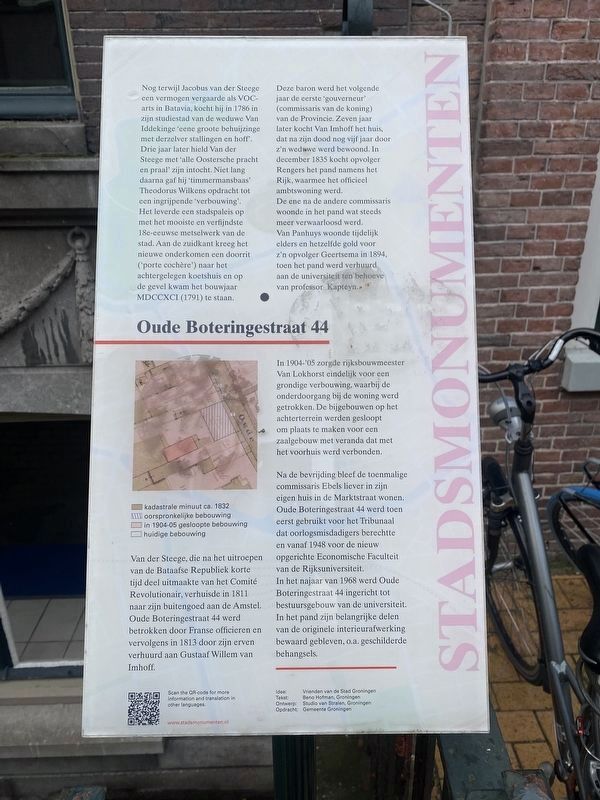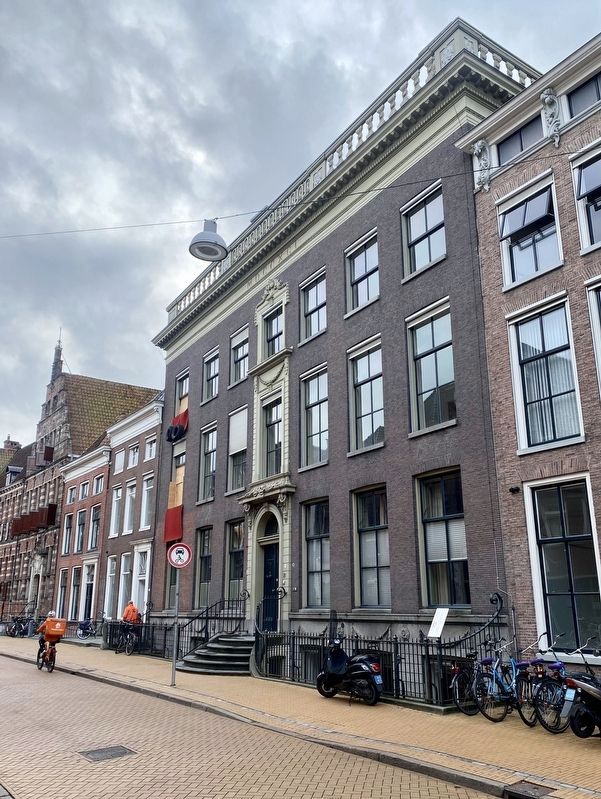Groningen, Netherlands — Northwestern Europe
Oude Boteringestraat 44
— Stadsmonumenten —
Nog terwijl Jacobus van der Steege een vermogen vergaarde als VOC-arts in Batavia, kocht hij in 1786 in zijn studiestad van de weduwe Van Iddekinge ‘eene groote behuijzinge met derzelver stallingen en hoff’. Drie jaar later hield Van der Steege met ‘alle Oostersche pracht en praal’ zijn intocht. Niet lang daarna gaf hij ‘timmermansbaas’ Theodorus Wilkens opdracht tot een ingrijpende ‘verbouwing’. Het leverde een stadspaleis op met het mooiste en verfijndste 18e-eeuwse metselwerk van de stad. Aan de zuidkant kreeg het nieuwe onderkomen een doorrit (‘porte cochère’) naar het achtergelegen koetshuis en op de gevel kwam het bouwjaar MDCCXCI (1791) te staan.
Van der Steege, die na het uitroepen van de Bataafse Republiek korte tijd deel uitmaakte van het Comité Revolutionair, verhuisde in 1811 naar zijn buitengoed aan de Amstel. Oude Boteringestraat 44 werd betrokken door Franse officieren en vervolgens in 1813 door zijn erven verhuurd aan Gustaaf Willem van Imhoff.
Deze baron werd het volgende jaar de eerste ‘gouverneur’ (commissaris van de koning) van de Provincie. Zeven jaar later kocht Van Imhoff het huis, dat na zijn dood nog vijf jaar door z’n weduwe werd bewoond. In december 1835 kocht opvolger Rengers het pand namens het Rijk, waarmee het officieel ambtswoning werd. De ene na de andere commissaris woonde in het pand wat steeds meer verwaarloosd werd. Van Panhuys woonde tijdelijk elders en hetzelfde gold voor z’n opvolger Geertsema in 1894, toen het pand werd verhuurd aan de universiteit ten behoeve van professor Kapteyn.
In 1904-’05 zorgde rijksbouwmeester Van Lokhorst eindelijk voor een grondige verbouwing, waarbij de onderdoorgang bij de woning werd getrokken. De bijgebouwen op het achterterrein werden gesloopt om plaats te maken voor een zaalgebouw met veranda dat met het voorhuis werd verbonden.
Na de bevrijding bleef de toenmalige commissaris Ebels liever in zijn eigen huis in de Marktstraat wonen. Oude Boteringestraat 44 werd toen eerst gebruikt voor het Tribunaal dat oorlogsmisdadigers berechtte en vanaf 1948 voor de nieuw opgerichte Economische Faculteit van de Rijksuniversiteit. In het najaar van 1968 werd Oude Boteringestraat 44 ingericht tot bestuursgebouw van de universiteit. In het pand zijn belangrijke delen van de originele interieurafwerking bewaard gebleven, o.a. geschilderde behangsels.
While Jacobus van der Steege was still gathering capital working as a doctor for the VOC in Batavia, he bought in 1786 in the city in which he had studied “eene groote behuijzinge met derzelver stallingen en hoff” from a widow Van Iddekinge. Three years later, Van der Steege made with “all Oriental splendour” his entry. Not long after he gave “carpenter boss” Theodorus Wilkens the assignment of a major “renovation”. It resulted in a city palace with the finest and most refined 18th-century masonry in the city. On the south side the new building was given a passage (“porte cochere”) to the rear coast house and on the facade, it said MDCCXCI (1791).
Van der Steege, who after the proclamation of the Batavian Republic was shortly a part of the Revolutionary Committee, moved in 1811 to his estate on the Amstel. Oude Boteringestraat 44 was inhabited by French officers and was then hired by his heirs to Gustaaf Willem van Imhoff in 1813.
In the following year, this baron became the first "governor" (Commissioner of the King) of the province. Seven years later, Van Imhoff bought the house, that after his death was inhabited by his widow for five years. In December 1835, successor Rengers bought the property on behalf of the government, which made it an official residence. Various commissioners lived in the increasingly neglected property. Van Panhuys temporarily lived elsewhere, as did his successor Geertsema in 1894, when the property was leased to the university on behalf of prof. Kapteyn.
In 1904-'05 government architect Van Lokhorst made a much-needed thorough renovation possible, with the passage lengthened throughout the house. The outbuildings on the rear area were demolished to make way for a hall building with a porch that was attached to the front house.
After the liberation Commissioner, Ebels preferred to continue living in his own house in the Marktstraat. Oude Boteringestraat 44 was first used for Tribunal that put war criminals to justice and from 1948 became home to the newly established Faculty of Economics of the University. In autumn 1968, Oude Boteringestraat 44 was appointed to become the administrative building of the university. Important parts of the original interior have been preserved in the building, among other things, painted wallpaper.
Erected by Gemeente Groningen. (Marker Number 91.)
Topics and series. This historical marker is listed in these topic lists: Education • Government & Politics. In addition, it is included in the Groningen Stadsmonumenten series list. A significant historical month for this entry is December 1835.
Location. 53° 13.211′ N, 6° 33.816′ E. Marker is in Groningen. Marker is on Oude Boteringestraat, on the right when traveling south. Touch for map. Marker is at or near this postal address: Oude Boteringestraat 44, Groningen 9712 GD, Netherlands. Touch for directions.
Other nearby markers. At least 8 other markers are within walking distance of this marker. Oude Boteringestraat 52 (within shouting distance of this marker); Oude Boteringestraat 36-38 (within shouting distance of this marker); Doopsgezinde Kerk / Mennonite Church (within shouting distance of this marker); Huis met de Dertien Tempels / House with the Thirteen Temples (about 90 meters away, measured in a direct line); Oude Ebbingstraat 39 (about 210 meters away); Spilsluizen 1-3 (about 240 meters away); Het Soephuis / The Soup House (about 240 meters away); Chez Dicque (about 240 meters away). Touch for a list and map of all markers in Groningen.
Credits. This page was last revised on December 31, 2023. It was originally submitted on January 6, 2023, by Andrew Ruppenstein of Lamorinda, California. This page has been viewed 66 times since then and 9 times this year. Photos: 1, 2. submitted on January 6, 2023, by Andrew Ruppenstein of Lamorinda, California.

